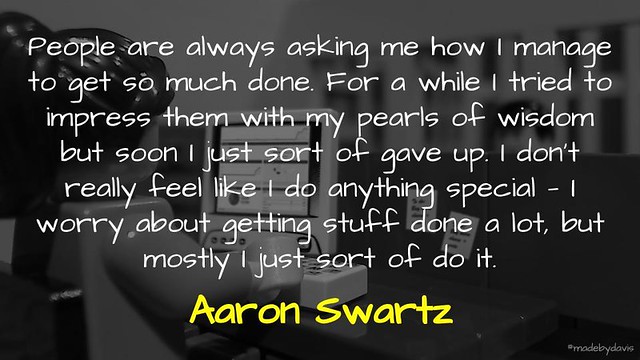
“Just sort of do it” by mrkrndvs is licensed under CC BY-SA
This post is in responses to the Edublogs Club prompt associated with classroom or office spaces. I am not sure I have that much to say in regards to the aesthetics of open planned working environment. However, I do have some thoughts on the digital spaces which I use to ‘get work done’.
As I have discussed elsewhere, my one word this year is communication. This has many facets, such as clarity of meaning, consistently responding, working collaboratively, adjusting to context and being transparent. It is something pertinent to my current job as an integration coach.
One particular challenge that I have found since transferring from the classroom into a more administrative role has been the importance of being organised. Often with the classroom there is a certain structure provided by way of classes, students and timetables. Bianca Hewes provides a useful example of this in her post on staying organised. Although I have had experience outside of the classroom before managing reports, timetables and daily organisation, most of these things had clear and consistent expectations too. I may have had my calendars and spreadsheets. However, the workflow was seemingly pre-defined by the wider organisation. My new role is different.
Although I am hired as a coach with the focus on supporting schools with the integration of technology, this support takes many forms. So far I have developed material to support the implementation of Digital Learning Technologies, organised material around Communities of Practice, help organise Stories of Practice, as well as created various presentations. What is different about leading various projects is that they each have unique tasks and timelines. The challenge then is managing everything. Two strategies I have used to communicate this work in an open and transparent manner are Kanban and the Priority Matrix.
Kanban
A means of project management, Kanban is an agile way of organising tasks. In its most basic form it involves three columns: to do, doing and done. However, there are many different iterations. Often Kanban is done using sticky notes in a public space. However, Trello provides a useful digital form. I started out using personal boards, but have since moved to progressively involving the wider team. What I like about Trello is the means of bringing together various documents, checklists and notes in the one space. In addition to this, there are options of organising things using categories or allocating people to specific cards or tasks.
Decision Matrix
Also known as the Eisenhower Method, the Decision Matrix is designed to use time on what is important. The matrix is split into four quadrants:
Urgent and important (tasks you will do immediately).
Important, but not urgent (tasks you will schedule to do later).
Urgent, but not important (tasks you will delegate to someone else).
Neither urgent nor important (tasks that you will eliminate).
As a means of organising each week, I usually list the various tasks that are on the go and use the categories to prioritise. While I also add anything else in as the week pans out. I do this using Google Slides as it allows me to link to further information, such as a Doc or a Trello Card. I find this useful for not only planning ahead, but also for being accountable in looking back at what I have done over time.
So that is me. That is how I get work done. So what about you? Do you have any suggestions for me? How do you get work done? As always, comments welcome.
If you enjoy what you read here, feel free to sign up for my monthly newsletter to catch up on all things learning, edtech and storytelling.
Getting Work Done by Aaron Davis is licensed under a Creative Commons Attribution-ShareAlike 4.0 International License.

I hadn’t really noticed it until now but I do use the Eisenhower Method. In my early career I worked as a clerk in an investment and I kinda flipped this idea around and called it “prioritising based on what tasks have the capacity to cause us the most amount of pain” (but in more colourful language).
Thanks for the comment. I am sure it has many names and many different interpretations.
Love the Decision Matrix! I will use this one! Thanks for sharing!
For a more indepth discussion, I recommend checking out Stephen Covey’s The Seven Habits of Highly Effective People where talks about ‘putting first things first’
I hadn’t heard of the Kaban method but it is definitely something I do even if it is unintentionally! Thanks for the inspiration to spend a little more time into how you organize yourself and your time!
Thanks Tara for the comment. I think that the catch with Kanban is that some are more stringent than others. I have read that you should not have more than three items in any of the columns. I must admit I probably could improve on the way I use it.